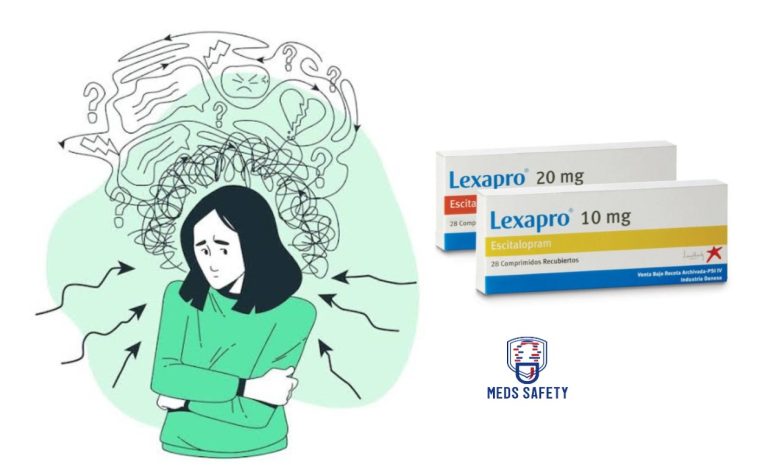10mg vs. 20mg Lexapro for Anxiety: Which is Better

Anxiety is a universal human emotion, a natural response to stress, uncertainty, or fear. It’s part of our innate defense mechanism, designed to alert us to potential dangers and help us prepare for challenges. However, for some individuals, anxiety can become a persistent and overwhelming force that disrupts daily life, evolving into an anxiety disorder. These disorders are a group of mental health conditions marked by intense, excessive, and often irrational worry, fear, and distress. They can vary in their specific symptoms and triggers, but they all share the common characteristic of heightened and often disruptive anxiety levels.
Living with anxiety can be a challenging and overwhelming experience. Lexapro, a commonly prescribed medication, has provided relief for many individuals suffering from anxiety disorders. However, when considering Lexapro, an important decision is choosing the right dosage. This article delves into the comprehensive comparison of two common doses: 10mg and 20mg of Lexapro for the treatment of anxiety.
10mg Lexapro
Effectiveness: For many individuals, starting with a lower dosage like 10mg can be highly effective in managing anxiety. It is often the initial prescription for those new to Lexapro. The gradual increase in serotonin levels in the brain helps reduce symptoms of anxiety, enhancing overall well-being.
Side Effects: The lower dosage is generally associated with fewer side effects compared to higher doses. Common side effects may include mild nausea, dizziness, and fatigue, but these often subside with continued use.
Adjustment Period: 10mg may have a shorter adjustment period, with users experiencing relief from anxiety symptoms within a few weeks. However, some individuals may find that the effectiveness plateaus, prompting consideration of a higher dose.
Recommended For: 10mg Lexapro is typically recommended for individuals with mild to moderate anxiety. It is often the starting point for treatment and can provide substantial relief for those within this range.
20mg Lexapro
Effectiveness: For individuals with more severe or treatment-resistant anxiety, a higher dose of 20mg Lexapro may be necessary. This dosage allows for a greater increase in serotonin levels, potentially providing more robust relief.
Side Effects: A higher dose can lead to an increased likelihood of side effects. Users might experience more pronounced symptoms such as nausea, dizziness, and sexual dysfunction. Monitoring and managing side effects may be more critical at this dosage.
Adjustment Period: The adjustment period for 20mg Lexapro may be longer, with users needing several weeks to experience the full benefits. It is essential to be patient and work closely with a healthcare professional to monitor progress.
Recommended For: 20mg Lexapro is typically recommended for individuals with severe, chronic, or treatment-resistant anxiety. It is considered when lower doses have not produced the desired relief.
Important Considerations
1. Individual Variability: The appropriate dosage of Lexapro varies from person to person. Factors such as the severity of anxiety, individual response to the medication, and side effects should guide the decision.
2. Medical Supervision: Determining the right dose should always be done under the supervision of a healthcare provider. They will consider your medical history, current condition, and treatment goals when making recommendations.
3. Medication Titration: In some cases, a gradual increase from 10mg to 20mg may be necessary if the lower dose does not provide sufficient relief. Titration should be done in consultation with a healthcare provider.
4. Combination Therapy: In cases of severe anxiety, a healthcare provider might recommend combining Lexapro with other treatment modalities, such as therapy or lifestyle changes.
10mg vs. 20mg Lexapro for Anxiety
The choice between 10mg and 20mg Lexapro for anxiety depends on the individual’s specific needs and response to the medication. Lower doses are generally effective for mild to moderate anxiety, with fewer side effects, while higher doses may be necessary for severe or treatment-resistant cases. Regardless of the dose, it’s crucial to maintain open communication with a healthcare provider to ensure the best treatment approach for your anxiety. Finding the right balance is key to managing anxiety and improving overall well-being.
Studies examining the use of Lexapro in the treatment of Major Depressive Disorder (MDD) have provided valuable insights into dosing strategies. For individuals with moderate MDD according to the Diagnostic and Statistical Manual of Mental Disorders, Fourth Edition (DSM-IV) criteria, research has shown that a starting dose of 10 mg of Lexapro per day is often the optimal choice. This dosage effectively alleviates the symptoms of moderate depression while minimizing the risk of side effects. Lexapro’s mechanism of action, which involves increasing serotonin availability in the brain, helps rebalance brain chemistry in those with depression. The 10 mg dose is generally well-tolerated and serves as a suitable starting point for addressing moderate depression without exposing patients to higher doses that may carry an increased risk of side effects.
For individuals dealing with moderate to severe depression, studies suggest that a higher dose of Lexapro at 20 mg per day is often more effective in providing relief. As depression reaches a certain severity, it often necessitates a stronger therapeutic response. This increased dosage ensures that an adequate amount of serotonin is available in the brain to address the more pronounced depressive symptoms. However, it’s crucial to acknowledge that not all individuals with moderate to severe depression will require a 20 mg dose. The choice of dosage should be made collaboratively between the individual and their healthcare provider, taking into account the specific characteristics of the depression and the patient’s response to the medication. The ultimate goal is to provide the most effective treatment while minimizing potential side effects and promoting overall well-being.
What side effects should I expect when taking Lexapro 10mg or 20mg?
The specific side effects of Lexapro, whether at 10mg or 20mg, can vary from person to person. It’s important to note that many individuals experience no side effects or only mild ones. However, some common side effects associated with Lexapro include:
Common Side Effects (may occur with 10mg or 20mg):
1. Nausea: Nausea is one of the most commonly reported side effects. It can often be managed by taking the medication with food.
2. Dry Mouth: Some people may experience a dry or cottonmouth sensation. Staying well-hydrated and using sugarless gum or candies can help alleviate this.
3. Fatigue: Feeling tired or drowsy is a common side effect. It’s advisable to take Lexapro before bedtime to minimize this effect.
4. Insomnia: On the flip side, some individuals may experience difficulty sleeping or insomnia when taking Lexapro. This side effect can also be managed by adjusting the timing of the medication.
5. Headache: Headaches, while not uncommon, are usually mild and transient. Over-the-counter pain relievers can help alleviate this symptom.
6. Gastrointestinal Upset: This may include symptoms like diarrhea or constipation. Maintaining a balanced diet and staying hydrated can assist with these symptoms.
Less Common Side Effects (more likely at 20mg or with long-term use):
1. Sexual Side Effects: This can include reduced libido, difficulty achieving orgasm, or erectile dysfunction.
2. Weight Changes: Some individuals may experience weight gain or weight loss while taking Lexapro.
3. Sweating: Increased sweating, especially at night, can occur as a side effect.
4. Dizziness: Feeling lightheaded or dizzy can occasionally occur.
5. Agitation or Restlessness: Some individuals may experience increased anxiety or restlessness when taking Lexapro.
It’s important to remember that not everyone will experience these side effects, and many find that the benefits of Lexapro in managing their condition far outweigh any side effects. Furthermore, side effects tend to diminish or disappear with continued use as the body adjusts to the medication.
If you experience severe or intolerable side effects, it’s crucial to contact your healthcare provider. They can provide guidance on how to manage the side effects, adjust the dosage, or explore alternative treatment options. Additionally, if you experience any unusual or severe symptoms, seek immediate medical attention, as rare but serious side effects can occur with any medication. Always communicate openly with your healthcare provider to ensure that Lexapro is effectively managing your condition with minimal side effects.





